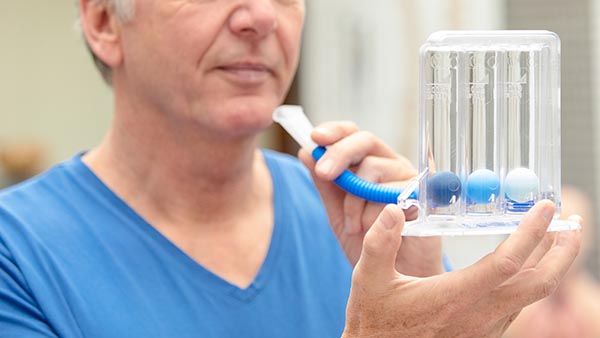– Dr Kanchan AnandHOD Physiotherapy Fortis Escorts Heart Insitute
SARS-Coronavirus-2 disease the pandemic that engulfed the globe and still showing no signs of reversal. It appears to be the utmost challenge for the country struggling to beat the pandemic by helping the people to fight COVID -19 in its acute phase and to put the people back to their normal levels of fitness even after the disease course is over.
Pulmonary rehabilitation is one way that has been proved most effective management strategies to improve breathing difficulty, health status, and exercise tolerance of patients with lung problems and showing promising results. One of the most important aspects of pulmonary rehabilitation is respiratory/breathing exercises.
WHY AND HOW BREATHING EXS HELPS
COVID-19 presents differently in different groups of people. One common symptom is inflammation in lungs and airways causing you to strive for breath.
People falling into severe category may develop pneumonia. Lungs get affected by filling themselves with fluid and mucus leaving the patient gasping for air. People with COPD/Asthma have compromised lung capacity and some amount of inflammation holding in lungs, which gets worsened if they catch COVID -19.
Breathing exercises are more beneficial for this set of people as it increases the lung capacity and improves lung ventilation as well as helps to clear the secretions from the lung.
These exercises also helps the patients to feel calm and relax thus reducing the anxiety levels during the course of disease.
DO BREATHING TECHNIQUES PREVENT COVID-19
Breathing exs. never prevents COVID-19, and should not be replacing your preventive measures like wearing masks, social distancing or getting a jab.it however strengthens your lungs thereby reducing the impact of disease on your respiratory system.
WHEN TO STOP BREATHING EXERCISES
If you find shortness of breath while resting, an irregular heartbeat or any kind of chest pain/heaviness, stop the exercise immediately. Consult your therapist before starting up again.
DRY COUGHING
It’s good to inhale deeply but not through your mouth, it will only leave you with more irritation and more extensive cough. Always breathe through nose as it warms and moistens the inhaled air .In COVID-19 mild cases people are developing more of dry cough.
POSITIONING
Proning is the main recommended position these days doing rounds on social media .Idea behind is to relieve pressure off the lungs that are surfaced on the back. When done in a hospital doctors monitor any changes that happens with change of position .This position is not helping the patients with huge bellies or pregnant females, so they should not be adapting this at home unmonitored. If you are struggling with your breath try to report to hospital rather managing urself at home with positioning.
FATIGUE
There is often a feeling of extreme tiredness associated with COVID-19.You may have lost some weight and muscle mass during the illness.Do Not Panic – as it may take weeks to months to recover fully .Only possible way is to gradually increase your activities and never strain urself at once. Take on small goals with in between rest periods .Do not hesitate to take a professional help to speed up your recovery period.
DECREASED EXERCISE TOLERANCE
This second COVID-19 wave had a hard impact on the younger population .people who are bread earners of the family needs to go out every day. The post-acute phase of the disease, patients are still experiencing breathlessness, fatigue and weakness of muscles and these symptoms are longing for quite a long time.
These symptoms if left unattended over a long period of time they can reduce the functional capacity, exs. tolerance and can hamper the life quality and produce a hindrance to work and daily chores.
As per WHO, rehabilitation plays an important role in improving these symptoms related to respiratory and musculoskeletal systems of the body
HOW PULMONARY REHAB WORKS
- EDUCATION-
The right piece of information is important to be passed to the patients, once they are getting discharged from the hospital. That needs to be taken care by a professional who can pass written material or videos of how to take care of yourself at home.
- EXERCISE
- RESPIRATORY EXS.
These exist. Play a major role in the acute phase and if symptoms persist they can be done for the next few weeks. Some of them are diaphragmatic breathing, deep breathing technique, pursed-lip breathing, lung clearance through postural drainage.
Very vigorous breathing exercises should be avoided in the acute phase as they can produce spasms in the chest.
As we progress we can start strengthening accessory respiratory muscles also.
B) MUSCULOSKELETAL EXS.
These are important to avoid the fatigue setting in for a longer duration of time. Gradually strengthening up the targeted muscle GPS is important and all need to be done 2-3times /week at starting of the recovery phase.
Give your respiratory and musculoskeletal system some time and at no point overstrain them in a rush to recover faster. We need to watch for vital signs even in the recovery phase like breathing difficulty, dizziness, cough, palpitations and any abnormal shooting muscular pains.
Consult the professional for best regimen to follow.
TELE REHABILITATION
Differing from the traditional method of PR delivery in a hospital-based environment, there is tremendous variation in delivering methods by Telerehabilitation.
This method is delivered by the teleconferencing software system. As the patients can attend the rehab sessions from the comfort of home we have a scope to involve more percentage of patients through this system.
The key here is to select the patients compatible for Tele rehab, those who are not holding any additional lung issues and can be managed safely by tele rehab. It involves real time visits with audio –video or both –virtual check ins, telephone assessments in recovery phase. This concept of tele rehab reduces patient contact time to “flatten the curve” of pandemic and is certainly a new hope for the people recovering in this second widespread wave of the disease.

